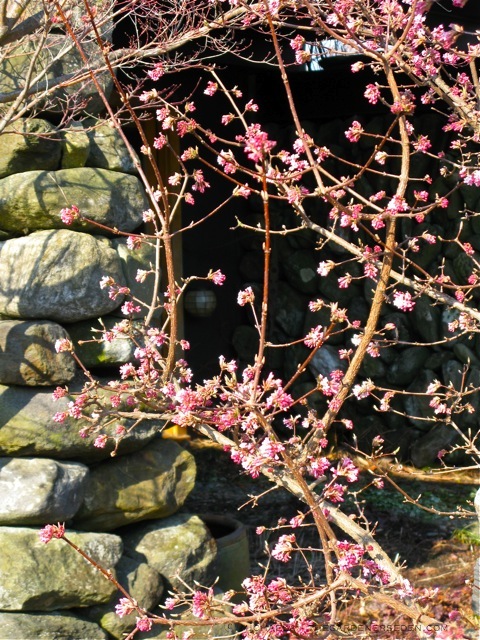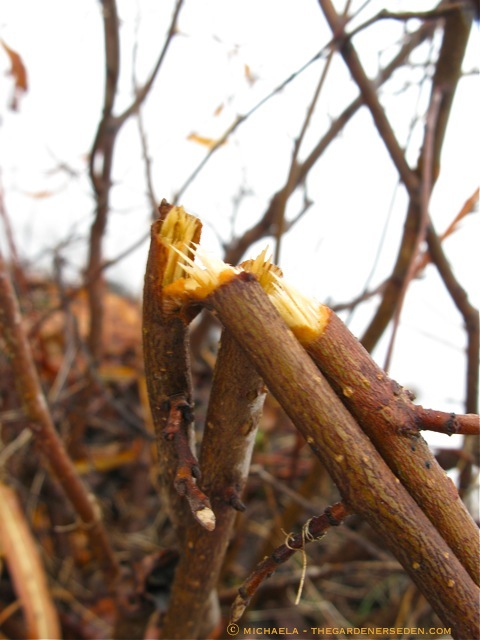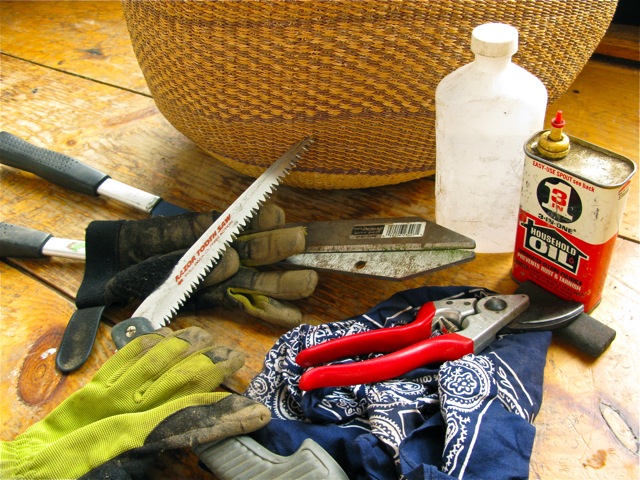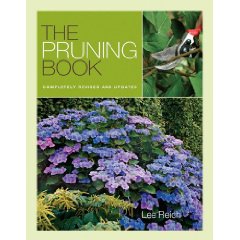Spring Clean-Up, Part One: Pruning Winter-Damaged Branches…
 Viburnum bodnantense ‘Dawn’ blooms early in the season. These flower buds were formed on old wood, last year. In general this shrub is only lightly pruned for shape, right after it has finished blooming. Damaged wood can and should be pruned anytime, as soon as it is observed.
Viburnum bodnantense ‘Dawn’ blooms early in the season. These flower buds were formed on old wood, last year. In general this shrub is only lightly pruned for shape, right after it has finished blooming. Damaged wood can and should be pruned anytime, as soon as it is observed.
After a long, tough winter, it sure is wonderful to see snowbanks finally receding from the garden and to sample the fragrance of a few early spring blossoms. As the weather cleared this afternoon, I spent a couple of hours looking over the emerging landscape, and while it was fun to get back in the garden, I made a few sad discoveries. Those sparkling ice storms were beautiful to behold this past winter, but it seems they left quite a trail of destruction in the garden. I will be spending the next few weeks checking for damage on ornamental trees and shrubs; pruning and cleaning up snapped limbs and branches.
 Beautiful But Destructive: The Scene from My Hilltop Earlier in the Year (see more ice photos here and here)
Beautiful But Destructive: The Scene from My Hilltop Earlier in the Year (see more ice photos here and here)
Pruning is a large subject —one I will be discussing throughout the growing season— but I have a few basic tips to share today, which are useful at any time of the year. Winter often takes a toll on woody garden plants, and it’s important to clean up splintered wood and ragged bark as soon as you notice it; before insects and disease move in. Take a close look at your garden now that the snow has (hopefully) melted back, and see how your trees and shrubs are doing. Spot any cracked limbs or branches? Now is the best time to address those problems. Later on in the season, flowers and foliage will hide structural damage, making it difficult to spot and much harder to tackle.
 Pruning a young Halesia tetraptera limb at the edge of the branch collar — branch broken by heavy icing— with a pair of sharp, clean bypass pruning shears. I use Felco #8 pruners for most small pruning tasks. Felco #6 pruners are a better model for those with very small hands.
Pruning a young Halesia tetraptera limb at the edge of the branch collar — branch broken by heavy icing— with a pair of sharp, clean bypass pruning shears. I use Felco #8 pruners for most small pruning tasks. Felco #6 pruners are a better model for those with very small hands.
But before you set off to begin cutting, the first —and most important— step, is to start work with clean, sharp pruners of the right type. Small branches and stems are easily tackled with bypass pruners and/or a pruning knife. Larger branches or small limbs —particularly those with tight or awkward angles— usually call for a Grecian saw (sometimes called a folding saw). And for all but the very largest limbs (which may require an arborist’s chainsaw) I recommend use of a bow saw. You can read more about these tools in my previous post (click here). In addition to these basic pruners, I also keep a few supplies for sharpening and sterilizing my tools close at hand. Rubbing alcohol, cotton rags, a can of household oil and a whetstone are the four most important items in my pruning tote. Before the season begins, I clean, sharpen and oil all of my pruning shears. And after pruning each tree and shrub, I carefully wipe down blades with a rubbing-alcohol-soaked rag. This step is key to preventing disease (often invisible to the naked eye) from spreading from plant to plant.
 The broken branches on this Fothergilla gardenii invite disease and insect infestation. Snapped in an awkward place along the main framework of the shrub, they are pruned down to the ground. Although it was a tough amputation to make, new growth produced this season will quickly fill in the gap.
The broken branches on this Fothergilla gardenii invite disease and insect infestation. Snapped in an awkward place along the main framework of the shrub, they are pruned down to the ground. Although it was a tough amputation to make, new growth produced this season will quickly fill in the gap.
Knowing how and where to make a clean cut on damaged wood is often what prevents gardeners from approaching pruning chores with confidence. This is a shame, because the basics of pruning are relatively simple, and once a gardener gets the hang of it, pruning often becomes a favorite —and even meditative— horticultural task. I love the art of pruning, and from a maintenance standpoint, the annual spring clean-up of woody plants is my favorite time of the year. Hands-on training is the best way to learn pruning techniques. If you have the opportunity to work with an good pruner, I highly recommend it. But if an experienced teacher is not on hand, there are several excellent resources available in print. For beginner to mid-level gardeners, I always recommend Lee Reich’s The Pruning Book. Straightforward and simple, but descriptively written and well illustrated, this is really the best title I have found on the subject.
I will be covering a few key pruning cuts in part two of this post (and also presenting a seminar on the subject at Walker Farm in Vermont, April 16th)In the meantime, take a look at the woody plants in your garden. See winter damage? If a limb is particularly large, high or near power lines, call a qualified arbortist for help. But if the damaged limbs and branches are on the small side, and low enough to the ground to be within your comfort zone, there’s no reason you can’t take care of this seasonal maintenance yourself. So pull out your tools and get them ready. We’ll be making some cuts in part two…
 Remember, always clean, dry, oil and sharpen tools both before and after each use. Disinfect pruners with rubbing alcohol after pruning is complete on each specimen.
Remember, always clean, dry, oil and sharpen tools both before and after each use. Disinfect pruners with rubbing alcohol after pruning is complete on each specimen.
***
Article and photographs (excepting book link) are copyright Michaela at The Gardener’s Eden, all rights reserved. All content on this site, (with noted exceptions), is the property of The Gardener’s Eden and may not be used, reproduced or reposted elsewhere without written consent. Do you enjoy The Gardener’s Eden? You can help support this site by shopping through affiliate links here. A small percentage of each sale will be paid to this site, helping to cover web hosting and maintenance costs. Thank you so much for your support!
***
4 Replies to “Spring Clean-Up, Part One: Pruning Winter-Damaged Branches…”
Comments are closed.



Oh, sorry about your babies! But at least you had a nice day for pruning. : )
Looking forward to your next posting. xo D.
Thanks for this piece. I thought of writing to ask you about the damaged state of my woody shrubs. I’ve never seen so many broken branches on such a variety of plants. My worst casualty is a Green Giant – actually broken when a helpful neighbor shoveled snow on it. And it leads me to a question: If a cedar has a large branch (1″ diameter) that is broken in half right at the join with the trunk, is it ever O.K. to leave it to see if both halves will survive?
As always, I am grateful for what you share. Polly
@ Deb – It has been a particularly rough year, indeed. But I did expect to find damage after all that icing, and once I get past the initial wince, the pruning is always an enjoyable task. ;) M
@ Polly – I am so sorry to hear about this damage! I think the destruction is very widespread this year on the east coast. In my pruning work, I am inclined to remove all truly broken and cracked wood. This was how I was trained to care for woody plants. Of course, in nature this is not how things work. Snapped branches sometimes remain hanging for years. Usually though, they collect water and begin to rot; sometimes opening the door to disease, or creating a convenient access point for insects. Breaks at the trunk or root join are generally considered permanent. You can always leave things as they are, and experiment (something I generally encourage to help with learning) but it’s important to remember that if you allow damaged wood to remain, other living organisms will eventually take advantage of the weak point, and you may lose the entire plant. I have seen gardeners attempt to salvage broken limbs with duct tape, and all sorts of salves. If the branch is only partially cracked (cambium not completely torn) and you catch it very quickly, this technique may work, perhaps in the short term. In the long term, the weak structure remains, and more vulnerable to ice, snow and wind damage in the future. If you are curious about how this all works, I would recommend studying grafting techniques, some of which may be found in literature on plant propagation.
I’ll be writing more on the subject of pruning and damage soon.
Good luck with your tree & shrub clean up! M
I appreciate your informative response. I would rather have a shrub with a hole than no shrub at all – so the broken branches are coming off. Then I’ll purchase Lee Reich’s book, as my go-to guide was published in ’68. Again, thanks! Polly